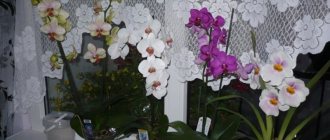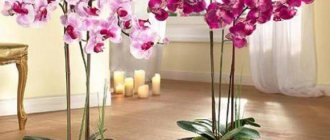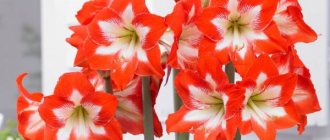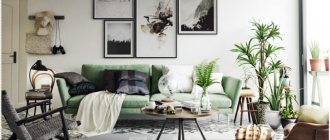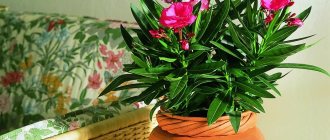How I wish summer didn’t end! The feeling of continuation of warm days, although there is rain and snow outside, will be created by flowering plants as messengers of summer. At the first stage, it’s simple: we dig up or buy garden flowers in the fall and they continue to bloom on the windowsill. Growing flowers from seeds at home is a difficult but exciting task. Experienced gardeners share the secrets of successfully growing flowers at home.
We'll tell you how to arrange a garden on a windowsill and enjoy lush blooms all year round. And very soon you will see that the late asters, oaks or chrysanthemums have not yet faded, and your babies are growing up, grown at home from seeds, which will replace the plants that have already fulfilled their duty. Asters, zinnias and violets can be grown at home from seeds even in winter.
Low tide installation
Installing flower pots at low tide without additional fastening is possible, but not always safe, even with a large width of the external window sill.
For high-rise buildings, this design is extremely undesirable. If other options are not considered, but you want to plant a flower garden, you must follow at least the simplest safety measures:
- Boxes should not extend beyond the edge of the window sill.
- The surface of the tide should not be too inclined. The slope can be adjusted with a wooden strip while placing the boxes.
- Tall and bushy plants should not be placed at low tide. It is better to give preference to small succulents.
To prevent the box from sliding down, you can make a temporary fence from a horizontally stretched chain or strong thread.
Flowers on the windowsill - harmonizing the space
It is probably impossible to say more succinctly, concisely and accurately than the poet described this process.
From the whimsical design schemes, from the fog of my ideas, the mystery of aquilegias and orchids, proud lilies, capricious mimosas grows in the apartment... My design in execution is simple: I arrange pots with life, beauty, directing it into growth.
And yet, let's leave poetry and return to prose. First of all, when selecting plants, it is necessary to take into account the design of the room - the color scheme and style. Consider the design of the containers in which the plants will be planted and the design of additional window elements.
For example, if you have forged items in the room, forged shelves with a multi-colored aster will look great on the windowsill.
Plain, strict flowerpots with terry, abundantly blooming zinnia - the only luxury items - will fit well into a minimalist-style interior. The black and white color scheme will be supported by black and white pots with dark purple or white violets.
Stationary fastening to the façade
The most reliable way to attach structures for flower boxes and pots is with stationary lattice or forged holders. They are screwed to the facade under the window and are not removed at the end of the flowering period.
With such an installation, it is important to identify the mounting locations in advance and select the optimal size. Limits that are too narrow will look unsightly; too wide ones will distract attention from the colors.
Planting and further care
Soak aster, violet or zinnia seeds in a weak solution of potassium permanganate for several hours. Place the seeds to a depth of 1-2 cm in the soil mixture. Shoots appear within a week. At this time, we water very carefully: seedlings with a still weak root system and an undeveloped crown are vulnerable to various infections. We start fertilizing as early as 2 weeks of age with complex mineral fertilizers and repeat it every 2 weeks, alternating with organic ones. Shortly before flowering, we use fertilizers with a high content of phosphorus and magnesium.
A month later, counting from seed germination, we transplant the seedlings to a permanent place, deepening the stem to form additional roots.
Asters, petunias, geraniums, or rather their modern varieties, do not need pinching. The violet itself forms creeping bushes that occupy the entire space. When growing zinnias at home, do not pinch them - this way the bud will form faster.
Fastening to external slopes
Installing boxes with flowers on facade mounts under the window has one drawback - until the plants stretch above the window line, it is impossible to enjoy them from the apartment. Low-growing flowers are not at all suitable for such a design.
The problem is solved by placing drawers at low tide in a decorative grille screwed to the slopes or using brackets. Installing such a structure does not require any special skills; it is enough to accurately adjust the width of the window.
Indoor plants in the interior of premises
Bedroom
Everything in the bedroom should contribute to a restful sleep.
Do not place plants in the bedroom next to the bed:
- they absorb carbon dioxide only during daylight hours;
- The smell of flowers can become very intrusive if you inhale these aromas for too long.
Opt for low-flowering and long-growing plants.
Suitable plants for the bedroom include chlorophytum, spathiphyllum, aloe, kalanchoe, begonia, geranium (pelargonium), sansevieria, myrtle, lavender and indoor jasmine.
Children's room
There are special requirements for premises for children.
Plants in the nursery should be arranged in such a way that the child cannot be injured by dropping or injuring a pot of flowers.
Children are inquisitive - they can touch or even taste everything they can reach.
Under no circumstances should you place plants (or their parts) that have poisonous sap (ivy, schefflera, fatsia, aglaonema changeable, spurge, monstera, dieffenbachia, oleander, poinsettia, spathiphyllum, ficus, cyclamen).
The same applies to plants with thorns or needles (cacti, roses).
Do not place scented or flowering plants in nurseries. Flower pollen is an allergen.
You should not provoke a child’s body, which has not yet formed protection from external influences, with constant additional stress on the immune system.
In the nursery, it is preferable to place sansevieria, lemon tree (produces phytoncides), Kalanchoe, chlorophytum, violet, cypress (has antibactericidal properties), begonia, Decembrist, hibiscus, tradescantia, peperomia.
But flowers are still needed for the nursery. Caring for plants instills hard work in children. Plants improve the aesthetics of a home, which also affects the psychological state and develops taste.
Kitchen
Plants can play different roles in the kitchen. This includes introducing curved lines into the geometry of the kitchen, purifying the air, and green color spots that are pleasing to the eye.
But not all indoor flowers are able to withstand excess heat and absorb fatty substances released during cooking.
Unpretentious plants include tradescantia, ivy, asparagus, cissus (all of them will look great on the walls, the top shelves of kitchen furniture, and on the refrigerator).
Place the orchid, violet, and chlorophytum on a window facing north, northwest or northeast to avoid direct sunlight.
Dieffenbachia, cacti, Ficus Benjamin, Zamioculcas of sufficiently large sizes can be placed in an elegant floor vase or a large beautiful tub on a floor stand, which will make it easier to move plants if necessary.
Decorative peppers placed on the windowsill can add a successful accent to the kitchen. Their bright fruits, when ripe, can be eaten as a spice.
Living room
Almost any plant can be placed in the living room. The environment should be cozy and become a relaxation area. Guests are received here and family members themselves gather here every day.
For a large living room, you can choose ficus, palm, hibiscus, large dracaena and oleander.
Get some plants whose light aroma can improve your mood - in large rooms they will not be so intrusive.
For small living rooms, you can choose hoya, aeschynanthus, saxifrage or any other plants of a more compact size.
To purify the air, it is good to place plants that have antimicrobial properties. These are oleander, pelargonium, spotted begonia, lemon tree and ficus.
Flowering plants relieve visual fatigue. Choose cyclamens, azaleas, graceful orchids, miniature roses or huge monsteras.
Lush plants with rich greenery will also be an excellent solution for decorating the living room.
Bathroom
It seems that flowers and the bathroom are incompatible concepts. But in fact, the bathroom creates ideal conditions for some types of plants due to its high humidity.
It's good when the bathroom has natural light.
Heart-shaped philodendron loves water and looks beautiful in hanging baskets or planters. For the peace lily, the best way to water it is by drenching the leaves.
Aloe vera grows well in sunlight, but can also live in artificial light.
Orchids are finicky, but they are tropical plants and the humidity in the bathroom will be ideal for them. They grow best in bright, indirect light, so they will produce fewer flowers in a windowless bathroom.
Lucky bamboo will do well in the bathroom; the plant does not like direct sunlight. It doesn't even require soil. It can be kept in a container with pebbles and water, which will add its own nuance to the bathroom interior.
Chlorophytum easily adapts to any growing conditions.
Sansevieria purifies the air and is not picky about placement conditions.
Ferns like regular watering and don't like bright light, so keeping them in the bathroom is a great idea.
You can also opt for shade-tolerant plants such as stromantha, arrowroot, cyperus, guzmania or aglaonema.
Flower pots on a chain or bracket
If the depth of the opening allows, hangers for flowerpots can be mounted above the window. You will need hooks or decorative brackets on which the chain is mounted. During the period of active flowering, the flowerpot turns into a lush fragrant cloud, pleasing to the eye.
Window grilles
Burglar-resistant metal bars can also be used to create a window garden. The market offers welded and forged structures with an inflated lower part.
You can place several boxes with greenery or flowers without additional fastening. The bends and monograms of the lattice will become a support for the hanging plants that have grown over the summer.
Tips and rules for where to put flowers in an apartment
How to place flowers on the windowsill?
No one will be happy with an assortment of indistinct plants among a pile of pots on the windowsill. Plant placement requires certain rules and some ideas.
If you have multiple plants, choose pots, containers or planters of the same style and color. Moreover, throughout the interior of the room, and not just on the windowsill.
The rhythm of plants placed at equal distances from each other will have a calming effect on the psyche.
Beautifully flowering plants or plants with a lush green head are best placed alone.
For small, numerous flowerpots, you can consider decorative vertical ladders along window openings or horizontal lines when hanging (climbing and hanging plants).
If you have small plants, the care conditions for which are the same in terms of watering and lighting, you can place them in a single flower box along the entire width of the window sill.
Plants look especially impressive (as if they are growing from a window sill) if such a flowerpot is “recessed” along its entire height into the recess of the window sill.
A mini-garden of succulents and other miniature plants is an excellent solution for small window sills.
A composition of such plants can be placed in glass flasks or an aquarium.
If you have plants of different shapes, it is better to organize several levels by placing a flower table in front of the window below the level of the window sill.
Placing flowers on the floor
Sufficiently tall and large plants can be placed on the floor. The container for such plants should be heavy to avoid tipping over. A low floor stand can be used for cleaning purposes.
A couple of plants on either side of the door will look interesting. For example, flowering standard trees or vines such as Philodendron and Monstera can be used as free-standing specimens. This will add symmetry to the large room near the patio door and bring a bit of the garden into the room.
Placing plants on a stand
Plants with beautiful elongated stems and openwork weaves look better in the interior on stands made of various materials. Now there are a lot of stylish floor designs suitable for any interior.
Placing flowers on the walls
Against the background of pastel shades of the walls, vines, ivy, cissus, and various tradescantia look good.
You can also achieve the opposite effect: place plants with light or contrasting leaves, or bright flowers against the background of dark wall surfaces.
Spreading plants will enliven the monotony of walls with vertical stripes.
Mini balcony for flowers
A flower balcony fits harmoniously into the exterior of a private house. The compact design is made of wood or plastic in the color of the shutters or window frame. There is a niche inside for installing boxes and flower pots.
Such structures, fixed at the base of the windows, give the house a special aesthetics and a feeling of being lived in.
How to choose indoor plants
The choice should be made on those representatives of the flora that will fit well with the overall style of the home if there is sufficient lighting.
Photophilous
Of course, most flowering indoor plants are light-loving. They will only be comfortable near sources of natural light. These are windows, winter gardens, greenhouses. Bromeliads or arrowroots, begonias, gardenias, other flowers - the choice of plants is limitless.
Shade-loving
No plant can grow without light, in complete shade. Shade-tolerant plants can be placed a maximum of 2 m from north-facing windows and no more than 3 m from windows facing other directions. In other cases, it is necessary to use artificial lighting.
Shade-tolerant plants include chlorophytum crested, aspidistra, aglaonema variable, ivy, rhombic rhombicum, green-leaved syngonium, peperomia, epipremnum, creeping callisia, tradescantia, scindapsus, cissus.
Exotic
When creating the proper conditions and knowing the nuances of care, some exotic plants are no more difficult to grow than any other indoor plants.
Such plants include desert rose, banana bush, brownish magnolia, curly boviea, clubmoss, coffee tree, guernia, titanopsis, bashful mimosa, takka.
In interior design, living plants give individuality and a unique finished look to the home.
Decorative shutters
In a private house, cottage or country house, the idea of a window flowerbed can be played up with the help of decorative shutters. To prevent the doors from swinging from the wind, special clamps are provided. To attach plants to the shutter, removable hooks, small brackets and hangers are used.
There are hundreds of examples of creating flower arrangements outside the window. You can experiment with the type of fastening, shape and material of containers, and come up with bright floral ensembles. A little persistence and even the most ordinary window will turn into a miniature fragrant garden, even if only for a few months.
Choosing plants and seeds
Many people associate childhood impressions of plants with certain colors. First of all, I remember the so-called “grandmother’s” flowers - zinnias, asters, petunias, nasturtiums, lobelias, geraniums, dahlias, daisies, violets, tagetes, lavender - ubiquitous and growing everywhere. And when the time comes to select plants for your home, these are the flowers you will want to grow on the windowsill.
And the choice will be justified: all of them are unpretentious to grow and will fit well into any home design.
Zinnias amaze with their “unfading” flowers. Their flowering continues for more than a month! Zinnias should be planted in pots with a volume of at least 3 liters; when planting in long flowerpots, the distance between them should be 30 cm. We choose a very bright place and be sure to install additional light. Zinnia seedlings appear after 5-7 days, and flowers open after 2.5-3 months. For cultivation, you need to select dwarf varieties with a height of no more than 50 cm.
Asters can be grown in small containers, even 1-2 liter ones; the pots should be at least 20 cm in height. Place them in the sunniest place, with additional light for at least 4 hours a day on sunny days and all day in bad weather. The germination rate of aster seeds decreases sharply if they are already 2 years old.
From the moment of planting until the opening of the aster flower, 3 months pass.
Tricolor violets (viola) are compact, graceful plants, 15-30 cm high. They can even be replanted while they are blooming and create a “bouquet” on the windowsill by choosing harmonious combinations of colors.
Violet has medicinal properties - it is used to treat bronchitis, tracheitis and other diseases.
Geraniums (pelargonium) and house violets (Saintpaulias), classic grandmother's houseplants, can be perfectly combined with garden flowers on the windowsill. They bloom almost all the time and create the effect of summer colors while you wait for the next bud of an aster or zinnia to open.
Ampelous petunias planted in flowerpots and hung at different levels will create a stylish composition on the window.
Lavender on the windowsill with other herbs will decorate the kitchen. It is valued for the essential oils secreted by the leaves, which are used as a sedative and for flavoring drinks. To the substrate for growing it, you must add 1 teaspoon of slaked lime per pot to create a neutral and slightly alkaline environment.
When growing lavender from seeds, they must be stratified (kept in the cold).
You can root lavender sold in grocery stores: treat a fresh cut with root, plant in a greenhouse with washed coconut peat.
